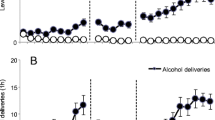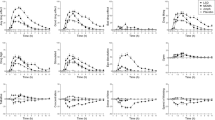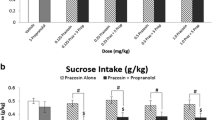Abstract
The effects of oral administration of ethanol [1.1 ml/kg 95% ethanol administered as a 20% (by volume) solution] and intravenous administration of the alpha2 adrenergic receptor antagonist yohimbine hydrochloride (0.4 mg/kg), alone and in combination, were compared using a double-blind, placebo-controlled design. Twelve healthy subjects completed 4 test days during which drug effects on subjective measures of intoxication and anxiety, plasma levels of the norepinephrine (NE) metabolite 3-methoxy-4-hydroxyphenylethylene glycol (MHPG) and cortisol, and cardiovascular indices were assessed. Acutely administered oral ethanol significantly increased the subjective measures of intoxication and anxiety, plasma MHPG, and sitting systolic blood pressure compared with placebo. Intravenous yohimbine significantly increased subjective measures of intoxication and anxiety, plasma MHPG and cortisol, and blood pressure relative to placebo. The ethanol-induced increase in plasma MHPG was significantly greater than that following yohimbine, whereas yohimbine resulted in significantly greater increases in anxiety, plasma cortisol, and blood pressure measurements than ethanol. The combined administration of ethanol and yohimbine had a clear additive effect of increasing the severity of acute intoxication compared with ethanol or yohimbine alone, and resulted in a significantly greater plasma MHPG response compared with either drug given alone. Although the pharmacokinetic effects of ethanol administration on NE metabolism must be considered, these findings suggest that the intoxicating and anxiogenic effects of acute ethanol administration may be associated with increased NE turnover, as measured by plasma MHPG, in healthy human subjects. In addition, these results indicate that ethanol and yohimbine may act additively to increase ethanol intoxication and that they may increase NE turnover through different physiological mechanisms.
Similar content being viewed by others
References
Ahlenius S, Carlsson A, Engel J, Svensson T, Södersten P (1973) Antagonism by alpha methyltyrosine of the ethanol-induced stimulation and euphoria in man. Clin Pharmacol Ther 14:586–591
American Psychiatric Association (1987) Diagnostic and statistical manual of mental disorders, 3rd edn, revised. American Psychiatric Association, Washington, DC
Andrade R, Aghajanian GK (1982) Single cell activity in the noradrenergic A-5 region: responses to drugs and peripheral manipulations of blood pressure. Brain Res 242:125–135
Blombery PA, Kopin IJ, Gordon EK, Markey SP, Ebert MH (1980) Conversion of MHPG to vanillylmandelic acid: implications for the importance of urinary MHPG. Arch Gen Psychiatry 37:1095–1098
Borg S, Kvande H, Sedvall G (1981) Central norepinephrine metabolism during alcohol intoxication in addicts and healthy volunteers. Science 213:1135–1137
Brier A, Charney DS, Heninger GR (1986) Agoraphobia with panic attacks: Development, diagnostic stability, and course of illness. Arch Gen Psychiatry 43:1029–1036
Cedarbaum JM, Aghajanian GK (1976) Noradrenergic neurons of the locus coeruleus: inhibition of epinephrine and activation by the alpha-antagonist piperoxane. Brain Res 112:413–419
Charney DS, Heninger GR, Sternberg DE (1982) Assessment of alpha2 adrenergic autoreceptor function in humans: effects of oral yohimbine. Life Sci 30:2033–2041
Charney DS, Heninger GR, Breier A (1984) Noradrenergic function in panic anxiety. Effects of yohimbine in healthy subjects and patients with agoraphobia and panic disorder. Arch Gen Psychiatry 41:751–763
Charney DS, Woods SW, Krystal JH, Nagy LM, Heninger GR (1992) Noradrenergic neuronal dysregulation in panic disorder: the effects of intravenous yohimbine and clonidine in panic disorder patients. Acta Psychiatr Scand 86:273–282
Davis VE, Brown H, Huff JA, Cashaw JL (1967) Ethanol-induced alterations of norepinephrine metabolism in man. J Lab Clin Med 69:787–799
Dekirmenjian H, Maas JW (1974) MHPG in plasma. Clin Chem Acta 52:203–208
Doxey JC, Lane AC, Roach AG, Virdee NK (1984) Comparison of the α-adrenoceptor antagonist profiles of idazoxan (RX 781094), yohimbine, rauwolscine, and corynanthine. Naunyn-Schmiedeberg's Arch Pharmacol 325:136–144
Durcan MJ, Lister RG, Linnoila M (1989a) Behavioral effects of alpha2 adrenoceptor antagonists and their interactions withethanol in tests of locomotion, exploration and anxiety in mice. Psychopharmacology 97:189–193
Durcan MJ, Wozniak KM, Lister RG, Linnoila M (1989b) Attenuation of hypothermic effects of ethanol by alpha2 adrenoceptor blockers. Eur J Pharmacol 166:381–386
Dwoskin LP, Neal BS, Sparber SB (1988) Evidence for anti-serotonergic properties of yohimbine. Pharmacol Biochem Behav 31:321–326
Ernsberger P, Giuliano R, Willette RN, Reis DJ (1990) Role of imidazole receptors in the vasodepressor response to clonidine analogs in the rostral ventrolateral medulla. J Pharmacol Exp Ther 253:408–418
George DT, Nutt DJ, Dwyer BA, Linnoila M (1990) Alcoholism and panic disorder: is the comorbidity more than coincidence? Acta Psychiatr Scand 81:97–107
Goldberg MR, Robinson D (1983) Yohimbine: a pharmacological probe for study of the α2-adrenoreceptor. Pharmacol Rev 35:143–180
Grunhaus L, Tiongco D, Zelnik T, Flegel P, Hollingsworth PJ, Smith CB (1989) Intravenous yohimbine selective enhancer of norepinephrine and cortisol secretion and systolic blood pressure in humans. Clin Neuropharmacol 12:106–114
Haraguchi M, Samson HH, Tolliver GA (1990) Reduction in oral ethanol self-administration in the rat by the 5-HT uptake blocker fluoxetine. Pharmacol Biochem Behav 35:259–262
Hunt WA (1993) Neuroscience research: How has it contributed to our understanding of alcohol abuse and alcoholism? A review. Alcoholism: Clin Expt Res 17:1055–1065
Hunt WA, Majchrowicz E (1974) Alterations in the turnover of brain norepinephrine and dopamine in alcohol-dependent rats. J Neurochem 23:549–552
Karoum F, Wyatt RJ, Majchrowicz E (1976) Brain concentrations of biogenic-amine metabolites in acutely treated and ethanol dependent rats. Br J Pharmacol 56:403–411
Karoum F, Mayer-Schwing J, Potkin SG, Wyatt RJ (1977) Presence of free sulfate and glucuronide conjugated MHPG in human brain, cerebrospinal fluid and plasma. Brain Res 125:333–339
Krystal JH, McDougle CJ, Woods SW, Price LH, Heninger GR, Charney DS (1992) Dose-response relationship for oral idazoxan effects in healthy human subjects: comparison with oral yohimbine. Psychopharmacology 108:313–319
Kushner MG, Sher KJ, Beitman RD (1990) The relationship between alcohol problems and the anxiety disorders. Am J Psychiatry 147:685–695
Langer SZ, Cavero I, Massinham R (1980) Recent developments in noradrenergic neurotransmission and its relevance to the mechanism of action of certain antihypertensive agents. Hypertension 2:372–382
Leckman JF, Maas JW (1984) Plasma MHPG: Relationship to brain noradrenergic systems and emerging clinical applications. In: Post RM, Ballenger JC (eds) Neurobiology of mood disorders. Williams & Wilkins, Baltimore, pp 529–538
Lister RG, Durcan MJ, Nutt DJ, Linnoila M (1989) Attenuation of ethanol intoxication by alpha2 adrenoceptor antagonists. Life Sci 44:111–119
Lukas SE, Mendelson JH (1988) Electroencephalographic activity and plasma ACTH during ethanol-induced euphoria. Biol Psychiatry 23:141–148
Maisto SA, Connors GJ, Tucker JA, McCollam JB (1980) Validation of the sensation scale, a measure of subjective physiological responses to alcohol. Behav Res Ther 18:37–43
Mullaney JA, Trippett CJ (1979) Alcohol dependence and phobias: Clinical description and relevance. Br J Psychiatry 135:565–573
Pohorecky LA, Jaffe LS (1975) Noradrenergic involvement in the acute effects of ethanol. Res Communi Chem Pathol Pharmacol 12:433–447
Portas CM, Devoto P, Gessa GL (1994) Effect of ethanol on extracellular 5-hydroxytryptamine output in rat frontal cortex. Eur J Pharmacol 270:123–125
Price LH, Charney DS, Heninger GR (1984) Three cases of manic symptoms following yohimbine administration. Am J Psychiatry 141:1264–1268
Redmond DE Jr (1987) Studies of the nucleus locus coeruleus in monkeys and hypotheses for neuropsychopharmacology. In: Meltzer HY (ed) Psychopharmacology: The third generation of progress. Raven Press, New York, pp 967–975
Rossetti ZL, Longu G, Mercuro G, Hmaidan Y, Gessa GL (1992) Biphasic effect of ethanol on noradrenaline release in the frontal cortex of awake rats. Alcohol Alcohol 27:477–480
Samson HH, Harris RA (1992) Neurobiology of alcohol abuse. Trends Pharmacol, Sci 13:206–211
SAS User's Guide: (1982) Statistics SAS Institute Cary, N.C.
Scatton B, Zivkivic B, Dedek J (1980) Antidopaminergic properties of yohimbine. J Pharmacol Exp Ther 215:494–499
Schuckit MA (1984) Subjective responses to alcohol in sons of alcoholics and control subjects. Arch Gen Psychiatry 41:879–884
Schuckit MA (1985) Ethanol-induced changes in body sway in men at high alcoholism risk. Arch Gen Psychiatry 42:375–379
Selzer ML, Vinokur A, Van Rooijen L (1975) A self-administered Short Michigan Alcoholism Screening Test (SMAST). J Stud Alcohol 36:117–126
Sher KJ, Walitzer KS (1986) Individual differences in the stressresponse-dampening effect of alcohol: a dose-response study. J Abnorm Psychol 95:159–167
SPSS User's Guide (1986) 2nd Edition. SPSS, Chicago, ILL.
Starke K, Borowski E, Endo T (1975) Preferential blockade of presynaptic α-adrenoceptors by yohimbine. Eur J Pharmacol 34:385–388
Stockwell T, Smail P, Hodgson R, Canter S (1984) Alcohol dependence and phobic anxiety states. II. A retrospective study. Br J Psychiatry 144:58–63
Wu PH, Liu J-F, Mihic SJ, Kalant H (1992) Arginine-8-vasopressin potentiates acute ethanol intoxication. Pharmacol Biochem Behav 41:409–414
Author information
Authors and Affiliations
Rights and permissions
About this article
Cite this article
McDougle, C.J., Price, L.H., Heninger, G.R. et al. Noradrenergic response to acute ethanol administration in heathly subjects: comparison with intravenous yohimbine. Psychopharmacology 118, 127–135 (1995). https://doi.org/10.1007/BF02245830
Received:
Revised:
Issue Date:
DOI: https://doi.org/10.1007/BF02245830




